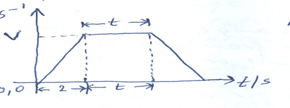Question 8
Part II. Candidates are expected to answer any three questions from this part.
- (i) Explain relative motion.
(ii) Two cars moving in opposite directions on the same straight road with
velocities 80 kmh-1 and 60 kmh-1 respectively pass each other at a point. Determine the velocity of the first car relative to the second car.
- (i) Define force.
- (ii) Classify the following forces as either contact forces or field forces: push;
tension; gravitational force; electrostatic force; reaction and magnetic force.
- A body starts from rest and travels in a straight line for 2 s with uniform acceleration of 1 ms-2. It then travels at a constant speed for some time before coming to rest with a uniform retardation of 2 ms-2. The total distance covered by it is 15 m.
(i) Draw and label a velocity-time graph for the motion.
(ii) Calculate the:
(α) velocity attained at the end of 2 s;
(β) total time taken for the journey.
Observation
Part (a): The first part of the question demanded more than mere definition of relative motion. Additional information in the form of example is required to score full mark. Some candidates also lost marks because they failed to include the frame of reference in their explanation.
The second part was well handled by most respondent. Few started off correctly with the formula but made wrong substitution. They did not know that the velocity of the second car was negative.
Part (b): Virtually all the candidates that answered this part got it right.
Part (c): Few candidates got the whole of this part correctly. Many were able to draw the correct diagram and got the calculation of velocity attained at the end of 2 s right. Some candidates, however, failed to indicate the origin (0,0) and label the axes correctly. Many respondent could not calculate the area of the trapezium of the graph correctly, hence they could not determine the total time taken for the journey.
The expected answers are:
(a)(i) This is a change in position measured from a point / frame of reference which may be stationary or moving
e.g - movement of a person walking inside a moving train
- a person inside a moving train observing a stationary observer/tree outside the
train.
(ii) Relative velocity, v.
v = vfirst - vsecond
= 80 – (- 60)
= 140 kmh -1 ( In the direction of the first car ).
(b)(i) Force is an agent that changes or tends to change the state of rest / uniform motion of a body.
OR
Push or pull.
(ii) Classification of forces
Contact Forces |
Field Forces |
Push |
Gravitational force |
(c)(i) V/ms-1

Axes correctly distinguished
Origin indicated (0,0)
Correct shape
(ii)(a)v = at1 = 1 x 2 = 2 ms-1
(ii) (β) Retardation a1 =
2=
= 1 s
Total distance covered (x) = area of trapezium
= ½ (t1 + t2 + t3 + t2) v
15 = ½ (t2 + t2 +3)2
= 2t2 + 3
t2 = 6s
Total time required = 6 + 3 = 9 s
